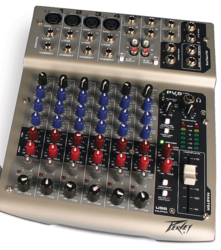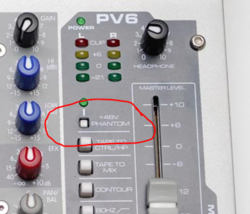So I have your basic handheld corded mic. I have a 10' cord from guitar center that is 1/4" on one end and female XLR on the other. Shouldn't the mic work when I plug it into the 1/4" input of a Peavey 6 channel mixer such as the PV-6? I get nothing.
Corded mic Question
- Thread starter BlueLineDJ
- Start date
You are using an out of date browser. It may not display this or other websites correctly.
You should upgrade or use an alternative browser.
You should upgrade or use an alternative browser.
Is it definitely a mic input and not a phone out? or audio out?
just making sure
do u have anything else u can test the cord on to see if its a bad cord?
cc
just making sure
do u have anything else u can test the cord on to see if its a bad cord?
cc
The 1/4" inputs on most mixers are "line level" .. the 1/4" off your cable is "mic level". The mixer channel should work, but you won't get much volume. You really want an XLR to XLR cable and go through the mic input.So I have your basic handheld corded mic. I have a 10' cord from guitar center that is 1/4" on one end and female XLR on the other. Shouldn't the mic work when I plug it into the 1/4" input of a Peavey 6 channel mixer such as the PV-6? I get nothing.
The cord is made that way, with a XLR on one end and the 1/4 on the other.Does it work without the extension? Is it a 10' mono cord?
Looks like you are correct ... Why the hell would they have 2 mixers with the same model number and different functionality ??? On the "black" one, as Prodjay said, the 1/4" jack is an output (for recording) .. on the silver one, the 1/4" is a line input.First, like Steve said XLR to XLR would be the best connection.
Now, which PV-6 do you have? black or white?
It looks like on the black one the 1/4" is an output only.
First, like Steve said XLR to XLR would be the best connection.
Now, which PV-6 do you have? black or white?
It looks like on the black one the 1/4" is an output only.

The input is a combo jack that can accept XLR or 1/4 inch. The jack below is a 1/4 inch out.
But, as Steve said you have an problem because the mixer is treating that as a line in vs. a mic in. If you switch to an XLR to XLR cable, it'll likely eliminate the problem immediately.
View attachment 36316
The input is a combo jack that can accept XLR or 1/4 inch. The jack below is a 1/4 inch out.
But, as Steve said you have an problem because the mixer is treating that as a line in vs. a mic in. If you switch to an XLR to XLR cable, it'll likely eliminate the problem immediately.
There you go, I missed the combo jack.
Yes.You said you had a 10' cord. Is this an extension? If so, does the mic work without the cord?
Sorry, it's this one I have.
Plugging into the 1/4 inch on that board, the mic must be line level to be heard. The XLR input, I believe it has a preamp behind it.
From the manual:
Mic XLR Inputs:
XLR balanced inputs optimized for a microphone or other low impedance source. Pin 2 is the positive input. Because of the wide range of gain adjustment, singla levels up to +14 dBu can be accomodated.
Line 1/4" Inputs:
1/4" balanced (TRS) 10k ohm impedance input. The tip is the positive input and should be used for unbalanced input. It has 20db less gain than the XLR input and does not have phantom power available. The Mic and Line inputs should not be used simultaneously
Last edited:
On that board, 1/4" is 20 db less and there is no phantom power available.
I don't disagree. The manual says - no phantom power across 1/4".
From the manual:
Line 1/4" Inputs:
1/4" balanced (TRS) 10k ohm impedance input. The tip is the positive input and should be used for unbalanced input. It has 20db less gain than the XLR input and does not have phantom power available. The Mic and Line inputs should not be used simultaneously
Yes .. not on 1/4" .. but that's also not for mics anyway.I don't disagree. The manual says - no phantom power across 1/4".
There are a lot of things that can go wrong here. What is the specific microphone model you are trying to use?
About 30 years ago the wring standard (if there even was one) for "Hi-Z" unbalanced mics in the U.S. changed to be consistent with European and world wide standards. If you have an older Hi-Z mic (50kOhm) the grounding scheme may be different and it won't work using a modern XLR-1/4" cable. (The same thing happens in reverse if your amp is expecting a balanced Low-Z mic) You would have to make your own cable or use a level matching transformer (1/4" to XLR) to make it work properly.
I had a lot of great old mics (cheaper versions of the SM58) that I used for karaoke and would have some color coded cables in order to make sure they were properly configured. Some of these old mics and equipment are still floating around out there.
If you have modern mic products, then the 1/4" connection is unbalanced, but not necessarily "Hi-Z" because it's impedance likely remains at 600 Ohms. It's not a good match for a true "Hi-Z" input. Most consumer and DJ class gear will deal with it just fine, but professional and industrial systems will often have more specific and less forgiving input configurations.
You can't apply phantom power coincident with an audio signal on anything less than a 3 wire circuit. So, if your mic needs phantom power (condenser) it will require and (XLR-XLR) or (XLR to TRS) connection.
About 30 years ago the wring standard (if there even was one) for "Hi-Z" unbalanced mics in the U.S. changed to be consistent with European and world wide standards. If you have an older Hi-Z mic (50kOhm) the grounding scheme may be different and it won't work using a modern XLR-1/4" cable. (The same thing happens in reverse if your amp is expecting a balanced Low-Z mic) You would have to make your own cable or use a level matching transformer (1/4" to XLR) to make it work properly.
I had a lot of great old mics (cheaper versions of the SM58) that I used for karaoke and would have some color coded cables in order to make sure they were properly configured. Some of these old mics and equipment are still floating around out there.
If you have modern mic products, then the 1/4" connection is unbalanced, but not necessarily "Hi-Z" because it's impedance likely remains at 600 Ohms. It's not a good match for a true "Hi-Z" input. Most consumer and DJ class gear will deal with it just fine, but professional and industrial systems will often have more specific and less forgiving input configurations.
You can't apply phantom power coincident with an audio signal on anything less than a 3 wire circuit. So, if your mic needs phantom power (condenser) it will require and (XLR-XLR) or (XLR to TRS) connection.
Last edited:




